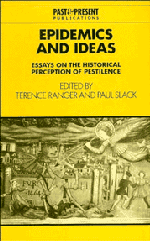Book contents
- Frontmatter
- Contents
- Contributors
- Preface
- 1 Introduction
- 2 Epidemic, ideas and classical Athenian society
- 3 Disease, dragons and saints: the management of epidemics in the Dark Ages
- 4 Epidemic disease in formal and popular thought in early Islamic Society
- 5 Plague and perceptions of the poor in early modern Italy
- 6 Dearth, dirt and fever epidemics: rewriting the history of British ‘public health’, 1780–1850
- 7 Epidemics and revolutions: cholera in nineteenth-century Europe
- 8 Hawaiian depopulation as a model for the Amerindian experience
- 9 Plague panic and epidemic politics in India, 1896–1914
- 10 Plagues of beasts and men; prophetic responses to epidemic in eastern and southern Africa
- 11 Syphilis in colonial East and Central Africa: the social construction of an epidemic
- 12 The early years of AIDS in the United Kingdom 1981–6: historical perspectives
- Index
- Past and Present Publications
5 - Plague and perceptions of the poor in early modern Italy
Published online by Cambridge University Press: 05 August 2011
- Frontmatter
- Contents
- Contributors
- Preface
- 1 Introduction
- 2 Epidemic, ideas and classical Athenian society
- 3 Disease, dragons and saints: the management of epidemics in the Dark Ages
- 4 Epidemic disease in formal and popular thought in early Islamic Society
- 5 Plague and perceptions of the poor in early modern Italy
- 6 Dearth, dirt and fever epidemics: rewriting the history of British ‘public health’, 1780–1850
- 7 Epidemics and revolutions: cholera in nineteenth-century Europe
- 8 Hawaiian depopulation as a model for the Amerindian experience
- 9 Plague panic and epidemic politics in India, 1896–1914
- 10 Plagues of beasts and men; prophetic responses to epidemic in eastern and southern Africa
- 11 Syphilis in colonial East and Central Africa: the social construction of an epidemic
- 12 The early years of AIDS in the United Kingdom 1981–6: historical perspectives
- Index
- Past and Present Publications
Summary
This chapter is concerned with ways in which outbreaks of pestilence influenced perceptions of the poor. Discussion will focus on the Italian states between the late fifteenth and the mid-seventeenth centuries, making occasional forays into other parts of Europe in search of contrasts and parallels. How did the threat of plague, and of those epidemic fevers that presaged it, ran concurrently with it or were mistaken for it, contribute to the mixture of pity and fear that characterised the attitudes of educated and authoritative people towards the poor in the early modern period? Much of the evidence will be drawn, at first or second hand, from legislative acts, and from chronicles, letters and reports compiled by clergymen and religious, by physicians, by professional men and by administrators. Their authors were generally pillars of urban society, proud that they had not fled from the plague, persons who saw in the countryside both a place of refuge for the less dutiful and stout-hearted, and a force which laid siege to the city, blockading its gates and approach roads, and withholding its supplies.
In 1630, with the onset of a terrible epidemic that was eventually to destroy more than 30 per cent of Venice's population, the Venetian senate passed two decrees intended to clear particular quarters of the city of the beggars infesting them. Issued on 22 June, the first decree seemed wholly dedicated to placating the wrath of God, of which the plague was the unmistakable sign.
- Type
- Chapter
- Information
- Epidemics and IdeasEssays on the Historical Perception of Pestilence, pp. 101 - 124Publisher: Cambridge University PressPrint publication year: 1992
- 12
- Cited by

